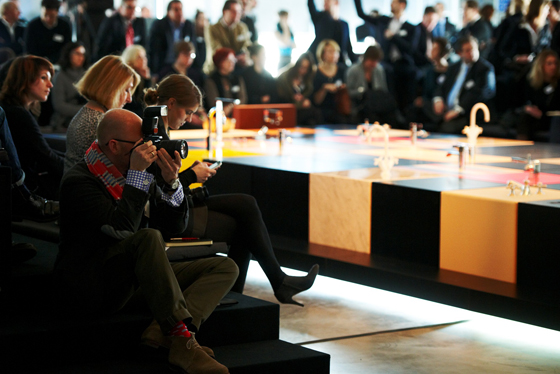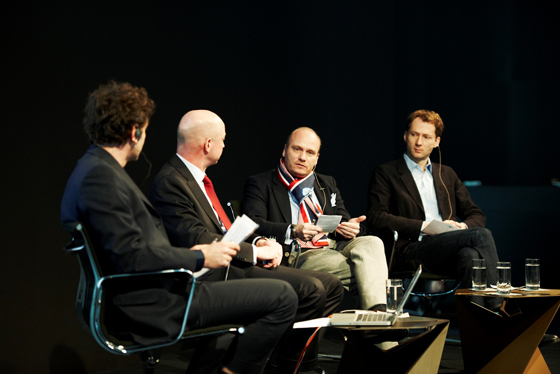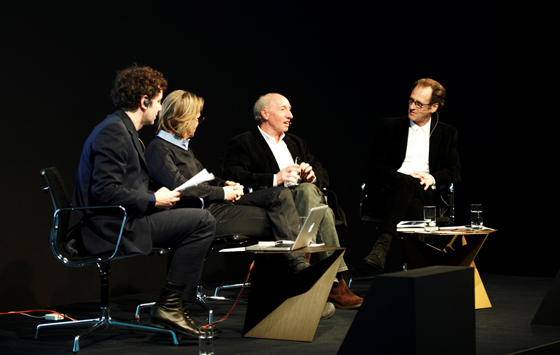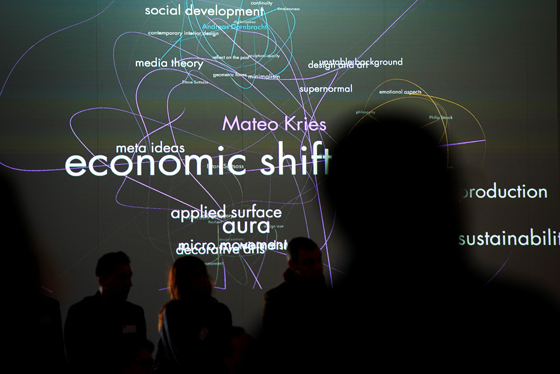People Will Talk: Dornbracht Conversations 3
Text von Simon Keane-Cowell
Zürich, Schweiz
11.03.11
Put a group of designers, curators and design writers in a room and what do you get? The Dornbracht Conversations. The third annual platform for intelligent dialogue on the state of design, past, present and future, hosted by German design manufacturer Dornbracht, took place last month, with a hundred or so invited design journalists and PRs in attendance. Here's our report on some of what was discussed, plus an invitation to you to have your say.
Marcus Fairs, founder of the now seminal online design magazine Dezeen, was charged with chairing the panel discussions at this year's Dornbracht Conversations

Marcus Fairs, founder of the now seminal online design magazine Dezeen, was charged with chairing the panel discussions at this year's Dornbracht Conversations
×Train to the airport. Flight to Düsseldorf. A hour-long taxi journey through some rather pretty German countryside. An invitation to high-end German bathroom-fittings manufacturer Dornbracht's base in Iserlohn to attend their annual one-day design pow-wow, the 'Dornbracht Conversations', requires a certain amount of legwork. But the meandering doesn't stop on arrival. Equally peripatetic were the panel discussions themselves, which attempted to address, perhaps a touch ambitiously, some Big Questions, such as 'Where are we now in design history?', 'What was the last significant design movement?' and 'How can the normal or ordinary be useful in thinking about, or shaping, design?'
It's always going to be tricky undertaking to attempt to tackle these kinds of questions in a such short space of time and, of course, on such a platform. Yet it would be churlish, or even cynical, to regard what Dornbracht is doing as simply an elaborate PR exercise. While there's no way of ignoring the commercial framework in which the whole event sits – the audience of invited international design journalists and public-relations bods were seated this year, amphitheatre-style, around a visually seductive, shiny installation of Dornbracht taps – the debate managed to transcend its immediate context to engage with some important ideas, while gesturing towards others. Moreover, you could argue that if we're talking, for the most part, about product design, then promoting such a 'conversation' under the auspices of industry has a logic to it.
Over a hundred international design journalists and PRs were invited by host Dornbracht to attend the third annual one-day design pow-wow in Iserlohn, Germany

Over a hundred international design journalists and PRs were invited by host Dornbracht to attend the third annual one-day design pow-wow in Iserlohn, Germany
×Marcus Fairs, the face of the now seminal online design magazine Dezeen, did a good job of chairing the two sessions, where he was joined in the morning by designer Michael Sieger, Vitra Museum curator Mateo Kries and Dornbracht CEO Andreas Dornbracht, and in the afternoon by creative director Mike Meiré, architect and designer Matteo Thun and author and critic Thomas Wagner. Kicking off the first panel discussion by asking the on-stage guests to identify the last meaningful design movement, Fairs wasn't, of course, getting all nostalgic on us. By asking us to think about the history of design, he was, by extension, inviting us to engage with how we think about design today – how the present can be defined through its difference from the past.
What's interesting is that both Andreas Dornbracht and Michael Sieger cited Memphis as the most recent significant movement. '[Through Memphis] I learned really to discover the sculptural value of a product,' said Dornbracht, while Sieger described the provocative Italian design collective, with its questioning of the ideas of function and taste, as 'the most radical break in the last 50 years of design history'. Indeed, Memphis did appear at a time (the early 1980s) when an ideologically watered-down form of modernism, the International Style, had had a long run of it, but it was Mateo Kreis who pointed out the possible reason for Memphis retaining such a privileged position in narrative of design history: you need an ideology to found a movement and, perhaps, that's what we're lacking. Movements, he argued, can today only be 'micro-movements', droog, with its 'questioning and irritating' form of communication with its users, being an example of this. Memphis, as far as Kries is concerned, couldn't happen now. It's simply 'not realistic in the age of brands and trends'.
'What was the last significant design movement?' was one of the questions posed by Marcus Fairs (left) to the panel during the morning session: Andreas Dornbracht (second from left), Michael Sieger (second from right) and Mateo Kries (right)

'What was the last significant design movement?' was one of the questions posed by Marcus Fairs (left) to the panel during the morning session: Andreas Dornbracht (second from left), Michael Sieger (second from right) and Mateo Kries (right)
×And why is this? Kries again: 'Society is undergoing major shifts. The volatile economic crisis is already being spoken of in the past. There's no stable background for a real movement to be established... There is nostalgia now for a movement.'
Then along came Matteo Thun in the afternoon, one of Memphis's co-founders, and dropped a bombshell. 'Memphis was shit,' he said, debunking the movement's quasi-mythic status in one fail swoop. 'Completely post-rationalised.' Most of what the collective produced was 'done after midnight, often drunk'. While admitting that 'we were pissed off with rationalism', with the influence that the postwar design school in Ulm had had (he described it as a bad copy to good original that was the Bauhaus), what Memphis produced was just messing about. 'We had no money', he explained to the audience, so it was about using what you could to make objects. And the prevalence of all those decorative surfaces, often interpreted as part of a postmodern, antagonistic discourse? They only had one sponsor and they made decorative laminates, so it was a case of 'Let's have some of that.'
So what's happening in design now? Can design solve some of the current problems society is facing, the way that modernism in the first half of the last century attempted to be socially engaged? Kries's answer was clear: 'Design alone cannot do this.' But this doesn't mean that it shouldn't try, he added. The cause of design and its effects are, however, complicated by the fact that what design means is always going to be contingent. 'Design means something different in different contexts,' explained the curator, for example in developing nations, where there is a different notion of need. What about design's very agency, its power to form a market, as well as to react to one? Kries's response was that the big manufacturers have the ability to do this – which is a rather interesting response given his paymaster.
Some of the key terms arising from the day's conversations
Sustainability was mentioned, of course, although Kries rightly pointed out that the role of representation in design (its discursive or rhetorical function, as I'd put it) will always get in the way of sustainability. 'Louder objects will always sell better,' he said, which is why a greater emphasis should be placed on the normal in design. Not the banal or the boring, but the useful.
The idea of the normal, or recognising the value in the ordinary – a concept that's often attributed to British designer Jasper Morrison and his discourse of the Super Normal – was one of the strands of discussion in the afternoon session, picked up by Mike Meiré, Matteo Thun and Thomas Wagner. Meiré argued that there's been a shifting of the goal posts: what was once considered ordinary is now seen as merely essential and boring, while the extraordinary has become the average. Wagner made the, perhaps obvious but important, point that normality is, of course, a construct, not a given: 'What was ever normal in the history of design?,' he asked. 'All of these terms change over time.' Indeed, Meiré admitted that 'what is ordinary for one person is extraordinary for others.' For him, the normal is played out in a type of design that 'comforts, that calms us down'. Yet, at the same time, design is about more than this: 'We are humans. Aside from functionality, we want a story,' he argued.
The afternoon session's panel, consisting of Mike Meiré (second from left), Thomas Wagner (second from right) and Matteo Thun (right), discuss, among other things, the role of the 'normal' in design

The afternoon session's panel, consisting of Mike Meiré (second from left), Thomas Wagner (second from right) and Matteo Thun (right), discuss, among other things, the role of the 'normal' in design
×While Meiré pushed the notion of a kind of plural, anti-dogmatic approach to design ('I want to step away from clear definitions' and 'We can take the icons down from the plinth and play with them' were just a couple of his let's-celebrate-design-as-a-free-for-all comments), Wagner voiced his concern that, in the absence of a current design movement, design becomes mere marketing. Indeed, such an anxiety was expressed by Jasper Morrison in his interview with Architonic late last year, where he talked about marketing-machine-led design 'trends'. For Wagner, there haven't been any real design '-isms' since the end of the 1970s. Yet, he said he doesn't see this as entirely negative. The question for him is what should we do now?
Maybe Matteo Thun has the answer. He cited 'Six Memos for the Next Millennium', published in the late 1980s and based on a series of Harvard lectures written by Italo Calvino, as a way of thinking about design, or, rather, what it should be. The memos were based on the values Calvino felt literature should possess in the new millennium – lightness, quickness, exactitude, visibility, multiplicity and consistency – but Thun suggested that these could equally be applied to design. 'Consistency', the last of Calvino's lectures, which was never completed due to the author's death, could signify, among other things, the aesthetic durability of designed objects, where they transcend the vicissitudes of trend.
But, in the spirit of the participatory nature of the Dornbracht Conversations, we thought we wouldn't let Matteo Thun have the last word. Instead, we invite you to join the dialogue.
Here are three questions based on the discussions at Dornbracht that you might want to have a go at yourself...
01) What, for you, was the last signficant design movement and why?
02) Do we need a new design movement or is this just fetishising dogma?
03) Is it important that design has a function beyond the utilitarian? If so, what?
.....





